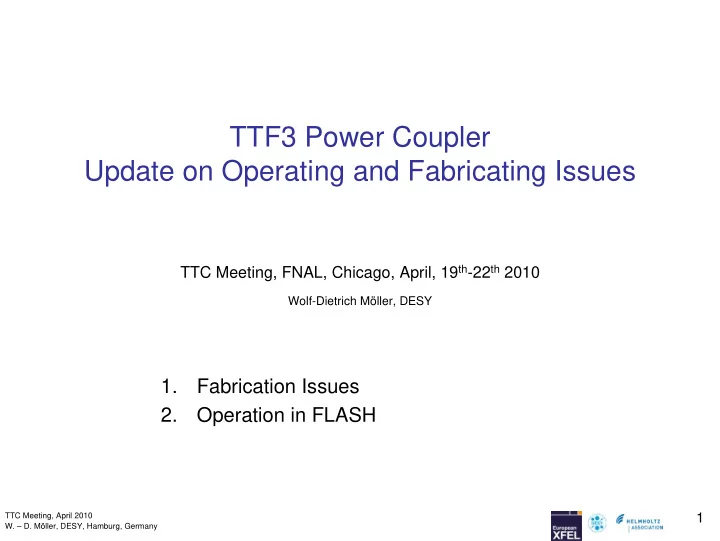

TTF3 Power Coupler Update on Operating and Fabricating Issues TTC Meeting, FNAL, Chicago, April, 19 th -22 th 2010 Wolf-Dietrich Möller, DESY 1. Fabrication Issues 2. Operation in FLASH TTC Meeting, April 2010 1 1 W. – D. Möller, DESY, Hamburg, Germany
Experience with the Fabrication of 139 TTF3 couplers, 1st • Critical fabrication steps: • Copper plating – blisters – adhesion • TIG welds – surface irregularities • e-beam – metal vapor – metal scratches from protective shields • Soldering – insufficient fill – material on flange surface TTC Meeting, April 2010 2 2 W. – D. Möller, DESY, Hamburg, Germany
Experience with the Fabrication of 139 TTF3 couplers, 2nd • Handling problems – dents at Conflat knife edges – dents at RF contacts – scratches on RF surface – chip at ceramic edge It is important that the companies understand the main functions and develop an adequate handling. TTC Meeting, April 2010 3 3 W. – D. Möller, DESY, Hamburg, Germany
TTF3 Power Coupler FLASH Operation Coupler type FNAL TTF 2 TTF 3 cold window conical cylindrical cylindrical warm window flat wave guide flat wave guide cylindrical bias no yes yes fabricated totally 16 20 139 tested 16 20 90 used in TTF modules 12 19 27 assembled in modules ACC 1, 2 ACC 2, 3, 4 ACC 1, 3, 5, 6 time of operation 1997 - 2005 1998 - 2005 2002 - 2009 ~ 105,000 coupler*hr ~ 115,000 coupler*hr ~ 700,000 (not updated) (not updated) coupler*hr FLASH operation (250-350kW) was never limited by the TTF3 power couplers, but… TTC Meeting, April 2010 4 4 W. – D. Möller, DESY, Hamburg, Germany
TTF3 Power Coupler after 5 years of Operation in FLASH, 1st wave guide box soldering burn marks inside wave guide box soldering burn marks outside TTC Meeting, April 2010 5 5 W. – D. Möller, DESY, Hamburg, Germany
TTF3 Power Coupler after 5 years of Operation in FLASH, 2nd warm part outer conductor burn marks (contact to WG) capacitor inner contact burn marks (contact to coax) TTC Meeting, April 2010 6 6 W. – D. Möller, DESY, Hamburg, Germany
TTF3 Power Coupler after 5 years of Operation, 3rd soldering problem TTF3 wave guide box is a soldered design: � micro cracks in the soldering caused sparks 2. TTF3 contacts are machined very precisely and have to be assembled very carefully: contact problem contact problem � misalignment caused contact problem sparks TTC Meeting, April 2010 7 7 W. – D. Möller, DESY, Hamburg, Germany
Solutions, soldered wave guide Soldering of the box is done by hand - the process is not easy to control. 1. machining from bulk Aluminium But: • flexibility for fabrication tolerances not easy to apply, redesign necessary (the original design has a membrane for length compensation) • braze wave guide • copper too soft • use copper plated stainless steel and keep the membrane part from copper (two test wave guides are under fabrication) TTC Meeting, April 2010 8 8 W. – D. Möller, DESY, Hamburg, Germany
Solutions, RF contact, 1st 1. Careful assembly we have many couplers tested and operated without any problems But: In a mass production we need a ‘fail safe’ solution 2. Change the design for RF spring or solid flange But: Not enough time for development and tests before XFEL production 3. Add contact seal between the flanges 4. Replace the capacitor (Chris Adolfsen, SLAC) TTC Meeting, April 2010 9 9 W. – D. Möller, DESY, Hamburg, Germany
Solutions, RF seal between flanges two seal solutions: • thin spring like Cu Be seal, tested – OK • soft copper seal, test just started TTC Meeting, April 2010 10 10 W. – D. Möller, DESY, Hamburg, Germany
Replacement of the capacitor, SLAC solution (Chris Adolfsen), 1st Bias was never necessary during FLASH operation • replacing the capacity by a copper membrane • membrane is clamped between flanges for good RF contact TTC Meeting, April 2010 11 11 W. – D. Möller, DESY, Hamburg, Germany
Replacement of the capacitor, SLAC RF test (Chris Adolfsen) TEST SUMMARY: POST TEST INSPECTION SHOW NO SIGNS OF ARCING TTC Meeting, April 2010 12 12 W. – D. Möller, DESY, Hamburg, Germany
Recommend
More recommend